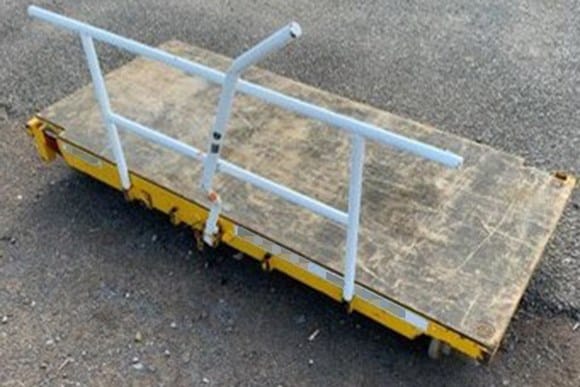Rail Accident Investigation Branch (RAIB) has today released a report into a collision between a passenger train and a hand trolley at Challow, Oxfordshire.
The incident, which took place on 21 October 2021, saw a passenger train, which was travelling at 123mph strike a hand trolley on the track near Challow. The train was the first to pass through an area which had been shut for overnight maintenance work.
No crew or passengers were injured, and the train did not derail, however the hand trolley was destroyed in the collision, and the debris caused damage to the underside of the train, and minor damage to the track.
The report has determined that after the completion of the overnight works, the team that handed back the track had not noticed the presence of the trolley on the track. A weakness in the line clear verification process was identified, which was compounded by the team failing to follow the process as required on the night concerned.
The identified underlying factors included:
- It was reliant on human actions for its successful implementation, which the rail industry had recognised, but not yet implemented any measures to avoid or mitigate errors.
- It was separate to the work planning process as defined by Network Rail’s company standards. This was a possible underlying factor.
- Network Rail’s assurance activities had not detected that staff in the Swindon delivery unit welding and grinding section were not complying with the line clear verification process. This was a possible underlying factor.
- A further probable underlying factor was that hand trolleys were being routinely used at night without displaying any red lights and that no assurance activities were taking place within work sites to monitor compliance to this requirement.
A further probable underlying factor was that hand trolleys were being routinely used at night without displaying any red lights and that no assurance activities were taking place within work sites to monitor compliance to this requirement.
RAIB observed that after the accident, the train was allowed to travel at a speed above that which should have been permitted given the level of damage it had sustained. RAIB also observed that there were multiple issues with how the work at Challow was planned by Network Rail.
RAIB has made five recommendations to Network Rail. The first is to establish how the existing line clear verification process can be improved while the second is to consider what technology could be used by its staff to support the process. The third recommendation is to propose an amendment to the Rule Book so that hand trolleys are required to display an illuminated red light in both directions at all times when on the track. The fourth is for Network Rail to have processes in place to ensure that any hand trolley placed on its track has illuminated red lights displayed in both directions. The fifth recommendation is to review the effectiveness of its safety assurance activities which check that hand trolleys are being used correctly and safely.
RAIB also identified three learning points. The first reminds maintenance staff about the importance of complying with all rules and standards concerning how trolleys and rail skates should be used on Network Rail’s infrastructure. The second highlights the importance of clear communication between the staff at a train involved in an accident and those based in control rooms to establish what damage has been sustained by a train, so that the appropriate controls can be put in place before the train is permitted to move. The third is that staff involved in planning maintenance work produce documents that are accurate, appropriate and specific for the task that is being carried out, and involve those responsible for the work in the planning of it.
Andrew Hall, chief inspector of rail accidents said: “Systems and processes designed to detect any equipment left on the track before lines re-open after maintenance work, should not be reliant solely on human performance in the middle of a dark night. There are technological solutions which can assist with addressing this issue, and this accident is an example of an opportunity missed.
“Our investigation found that the railway had identified the risk of equipment, such as hand trolleys, being left on the line and that it could mitigate this risk by improving the line clear verification process. However, it had not yet implemented the changes required when this accident occurred. This meant that the process remained vulnerable to human error. In this case, this vulnerability was made worse because relevant procedures were not followed correctly. Technology has an important role to play in improving the safety of the railway and it is important that the development of solutions to better support staff are prioritised. “It is also a concern that hand trolleys were routinely being used on the track at night without displaying red lights. But it is of equal concern that no activity to monitor this requirement was being undertaken. Once again, assurance activities intended to check that rules are being followed and that processes are being implemented correctly were not effective.”



































 0113 2082620
0113 2082620 info@railbusinessdaily.com
info@railbusinessdaily.com 15 Mariner Court, Wakefield WF4 3FL
15 Mariner Court, Wakefield WF4 3FL

